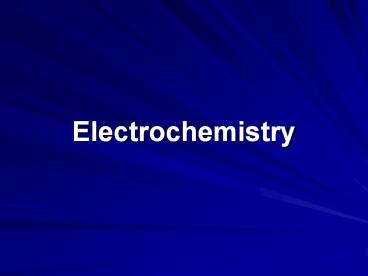Electrochemistry PowerPoint PPT Presentation
1 / 20
Title: Electrochemistry
1
Electrochemistry
2
- The study of the exchange of chemical and
electrical energy. - Oxidation-Reduction reactions take place in
electrochemical cells. - Each electrochemical cell consists of two solid
conductors called electrodes.
3
- Two types of electrochemical cells
- Voltaic Cell
- Electrolytic Cell
4
Voltaic Cell
- Reactions are spontaneous (Table J)
- Redox reactions produce electrical energy
- Lets look at an example
- Cu2 (aq) Zn (s) -------gt Cu (s) Zn2 (aq)
5
- Each Voltaic cell is composed of two half cells.
Zinc electrode
Copper electrode
6
The anode, is the electrode where the oxidation
of zinc occurs Zn (s) ----------gt Zn2 (aq)
2e- As zinc is oxidized, the zinc electrode
will slowly dissolve to produce zinc ions, which
enter into the solution.
Anode (negative)
7
The cathode is the electrode where the reduction
of copper occurs Cu2 (aq) 2e- -------gt Cu
(s) As copper is reduced, copper atoms
accumulate on the surface of the solid copper
electrode.
Cathode (positive)
8
Looking at the two cells, can a redox reaction
take place?
The reaction will not occur. There is no way for
the electrons lost by Zinc to get over to the
Copper ions and reduce them to Copper metal.
9
What if we provide a path for the electrons
released by the oxidation of the zinc to get over
to the copper?
Now that the electrons have a path to the Cu/Cu2
side it would appear that the reaction can
proceed,
Why?
but it does not.
10
- As the redox reaction proceeds
- There is a build up of Zn2 ions in the solution
where the Zinc is being oxidized - At the same time, Cu2 ions are removed from
solution where the Copper ion is being reduced - As a result, there is a build up of a positive
charge in the zinc solution, and a negative
charge in the copper solution. These charges do
not allow electrons to flow. - The positive charge in the zinc solution makes it
harder for the negative electrons to leave and
the negative charge in the copper solution repels
the electrons that are trying to come over from
the zinc side
We need a way to neutralize the charge build-up
in the solutions due to the change in ion
concentration
11
What if we had a tube filled with aqueous
solution that connected the two redox reactions?
Electron flow
This tube contains an electrolyte and is called a
salt bridge.
12
The salt bridge allows the electrons to flow,
keeping the overall concentration of ions in
balance between the two sides.
By connecting the salt bridge we have movement of
both types of ions anions are going into the
oxidation side and cations are going into the
reduction side
13
(No Transcript)
14
- Standard Cell potential
- Electrical energy produced by a redox reaction
is measured as voltage - Some standard electrode potentials are listed
below. - Electrode Process
Eo/V - Li(aq) e- ? Li(s)
-3.03 - K(aq) e- ? K(s)
-2.92 - Zn2(aq) 2e- ? Zn(s)
-0.76 - Cu2(aq) 2e- ? Cu(s)
0.34
15
Standard Cell Potential for Zn and Cu is 1.1
volts
16
Electrolytic Cell
- Reactions are non spontaneous
- Redox reactions require electrical energy to
occur
17
Anions are attracted towards the anode where they
undergo oxidation.
Electrons flow from the anode to the cathode
where cations undergo reduction.
18
Voltaic Cell vs Electrolytic Cell
19
Use of Electrochemical Cell
- A common dry
- cell battery.
20
Use of Electrolytic Cell
- Electroplating
- Electrolysis of water

